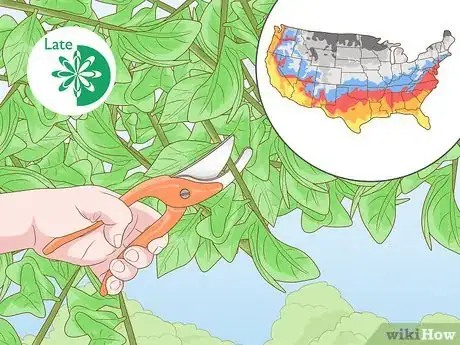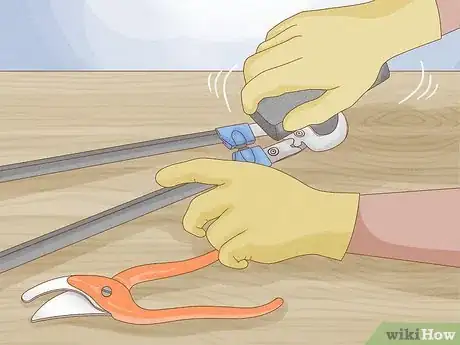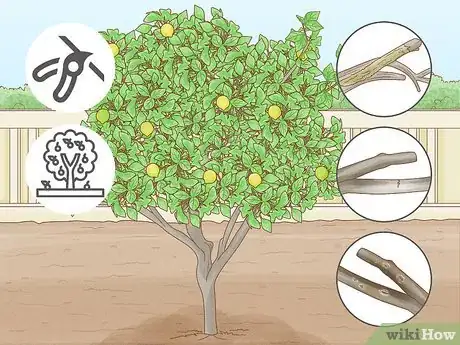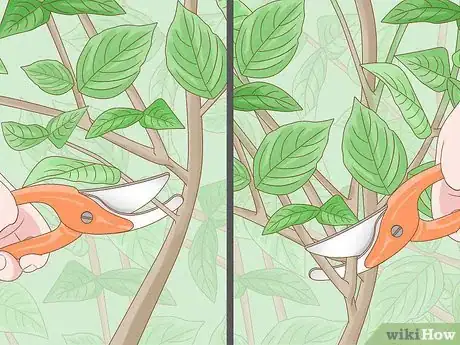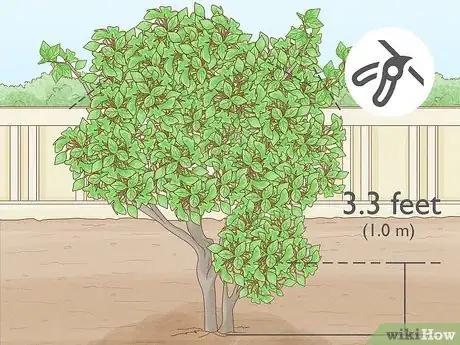This article was co-authored by Lauren Kurtz and by wikiHow staff writer, Sophia Latorre. Lauren Kurtz is a Naturalist and Horticultural Specialist. Lauren has worked for Aurora, Colorado managing the Water-Wise Garden at Aurora Municipal Center for the Water Conservation Department. She earned a BA in Environmental and Sustainability Studies from Western Michigan University in 2014.
This article has been viewed 91,201 times.
Pruning a lime tree has many benefits, such as improving air flow, strengthening limbs, and reducing risk of disease. It's also a simple and straightforward task that you can do yourself. The right time to prune a lime tree depends on your location and climate, but you can plan to do it once every year or 2 years. With a critical eye and a little time and effort, you can prune a lime tree to keep it healthy and looking great!
Things You Should Know
- Prune your lime tree twice a year after removing all of the fruit on the tree.
- If you live in a frost-free zone, prune in late winter and if you live in a frost-prone zone, wait until late spring.
- Using sharpened sheers, remove dead, damaged, diseased, and overgrown branches.
Steps
Choosing the Right Time
-
1Prune lime trees every year or 2 years depending on branch health. To help the lime tree grow as large and healthy as possible, you'll need to prune it regularly. Aim for a pruning schedule of once per year or once every 2 years. Inspect your tree in the spring to determine if it has dead, diseased, crossed, or tangled branches. If so, plan to prune the tree that year and if not, you can wait until the following year.[1]
-
2Aim to prune the tree in late winter if you live in a frost-free zone. If you live in a warm climate, you should prune the lime tree after harvesting the fruit for the season. The flowers that will produce limes for the next season will be visible, allowing you to easily decide which areas to prune.[2]Advertisement
-
3Wait until late spring to prune the tree if you live in a frost-prone zone. If you live in a cold climate, you should wait until the risk of frost has passed to prune the lime tree. Do an online search to find the average frost dates for your location, and wait until after this date to prune the tree so new growth isn't damaged by frost.[3]
- If your lime tree has frost damage, wait until it has new growth to prune it.[4]
-
4Remove any remaining fruit prior to pruning. If you're pruning the tree right after a harvest, make sure no limes remain on the tree. Carefully pick off any remaining fruit so you can clearly see and access the branches for pruning.[5]
Cutting Correctly
-
1Sharpen your shears or loppers before pruning the tree. Not only is it easier to cut branches with sharp tools, it's also better for the tree.[6] A clean cut heals faster, allowing the plant to devote its energy to bearing fruit and resisting disease and insects. To sharpen your tools, use a carborundum stone or diamond file and always take precautions to prevent injuries.
-
2Remove dead, damaged, and diseased branches at their base. All diseased, damaged, or dead branches should be removed to allow the tree to put its energy toward developing healthy branches and fruit. Cut the branches as close to the base as possible. Bag and dispose of these branches to prevent the disease from spreading.[7]
-
3Disinfect your shears or loppers after removing diseased branches. To prevent disease from spreading, you should always clean your tools after cutting diseased branches.[8] Use bleach or 10% methylated spirit water to disinfect the tools, then rinse them thoroughly with tap water and dry them with a clean cloth, taking care not to cut yourself.[9]
- If you use bleach, be sure to dilute it first. Mix 1 part bleach with 9 parts water before disinfecting your shears.
-
4Thin out areas with weak, crossed, or tangled branches. Weak branches will be unable to hold the weight of the fruit, so it's best to remove them before they break.[10] Crossed or tangled branches rub together, removing the bark and exposing the wood to diseases and pests. To avoid these issues, make sure to remove them at the base of the branch.[11]
-
5Trim branches that go beyond the desired size and shape of the tree. Long branches and those that stick out above the canopy can be trimmed. So can those that skim, or almost skim, the ground, as these branches are most susceptible to fungus and disease. Aim to lift the “skirt,” or bottom of the tree, 3.3 feet (1.0 m) from the ground.[12] Make the cuts 1⁄4 inch (0.64 cm) above the bud for best results. The goal is to create an attractive, balanced tree.[13]
-
6Avoid opening up the tree's canopy. While long or unruly branches can be trimmed from the canopy, you should avoid lacing a citrus tree. Lacing means opening up the canopy to allow sunlight to reach the interior of the tree. Some fruit trees, like plum and peach trees, benefit from lacing, but lime trees do not. Let the canopy grow naturally to prevent the tree from getting sunburned.[14]
Community Q&A
-
QuestionAfter pruning, should I paint the trunk and some of the branches with a white wash?
 Community AnswerDepending on the season, yes. Citrus trees need protection from the sun and whitewash is used as a sunscreen. Put it on during the sunny season and it will wash away when it gets rainy.
Community AnswerDepending on the season, yes. Citrus trees need protection from the sun and whitewash is used as a sunscreen. Put it on during the sunny season and it will wash away when it gets rainy. -
QuestionMy lime tree is full of new fruit, many in clusters. Should I remove some of the tiny limes to allow others to grow, or will they fall of naturally?
 Sliu63Community AnswerYou should remove the small ones so the others can grow bigger. Fertilize the tree to make them grow bigger.
Sliu63Community AnswerYou should remove the small ones so the others can grow bigger. Fertilize the tree to make them grow bigger.
References
- ↑ https://www.gardeningknowhow.com/edible/fruits/lime/tips-for-pruning-lime-tree.htm
- ↑ https://www.organicgardener.com.au/articles/making-citrus-cut
- ↑ https://www.organicgardener.com.au/articles/making-citrus-cut
- ↑ https://www.gardeningknowhow.com/edible/fruits/lime/tips-for-pruning-lime-tree.htm
- ↑ https://www.gardeningknowhow.com/edible/fruits/lime/tips-for-pruning-lime-tree.htm
- ↑ https://www.gardeningknowhow.com/edible/fruits/lime/tips-for-pruning-lime-tree.htm
- ↑ https://www.rhs.org.uk/advice/profile?PID=233
- ↑ https://www.rhs.org.uk/advice/profile?PID=233
- ↑ https://www.organicgardener.com.au/articles/making-citrus-cut
- ↑ https://www.gardeningknowhow.com/edible/fruits/lime/tips-for-pruning-lime-tree.htm
- ↑ https://www.organicgardener.com.au/articles/making-citrus-cut
- ↑ https://www.organicgardener.com.au/articles/making-citrus-cut
- ↑ https://www.rhs.org.uk/advice/profile?PID=233
- ↑ http://gregalder.com/yardposts/when-and-how-to-prune-citrus-trees/


